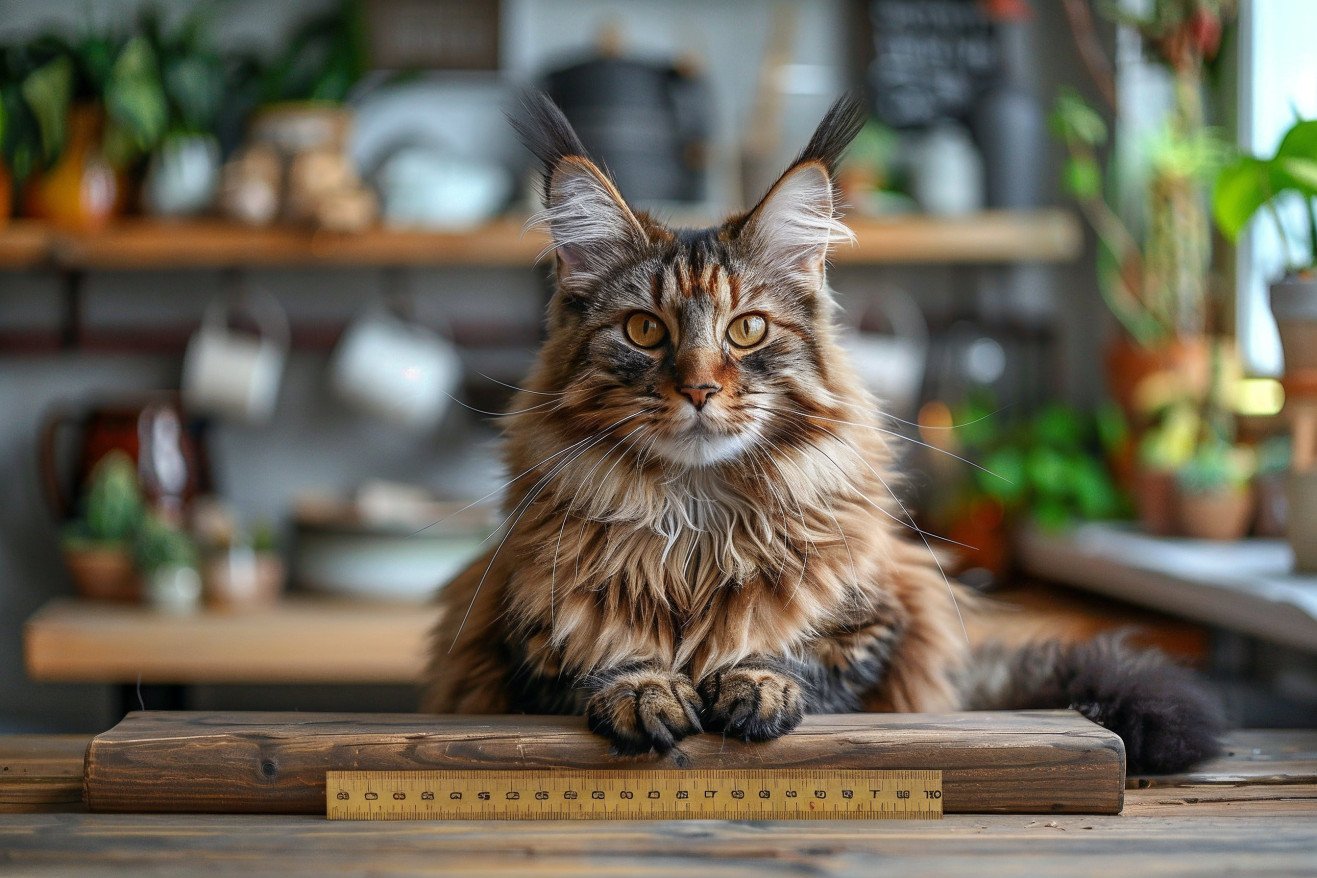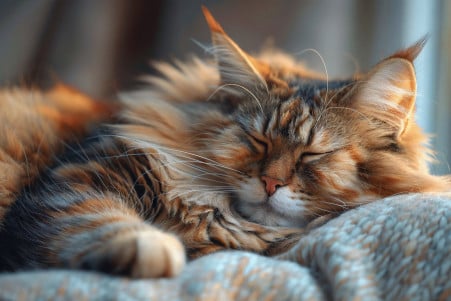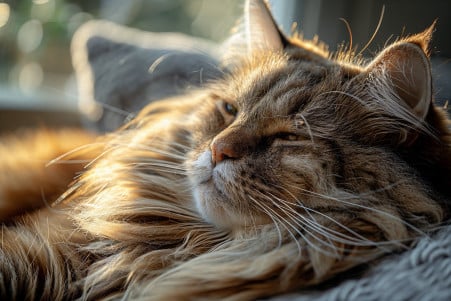Maine Coon Cats Size Guide: How Big Are Maine Coons?
3 March 2024 • Updated 2 March 2024

Maine Coon cats are known for their large size, and they are one of the biggest domesticated cat breeds. On average, male Maine Coons weigh between 15–25 pounds and females weigh between 10–15 pounds. They can also measure up to 40 inches long and 10–16 inches tall at the shoulder, and they usually reach their full size by the time they are 4 to 5 years old.
In this article, we will take a deep dive into the research on Maine Coon cat size, covering studies in veterinary science, genetics, and feline nutrition. These studies will help us understand the many factors that influence Maine Coon cat size, including genetics, health, and diet. Our goal is to provide insights that will help potential and current owners understand the care and living requirements of these big cats.
How big are Maine Coons?
Maine Coon Cat Size: The Gentle Giants Up Close
Maine Coon cats are known for their impressive size, which sets them apart from other cats. Males average 15 to 25 pounds and can grow up to 48 inches long, including their tails, according to Basepaws, which cites the measurements of Guinness World Record holder Stewie.
Meanwhile, females are a bit smaller, weighing between 10 and 15 pounds and measuring 8 to 14 inches tall when fully grown. These measurements are much larger than those of most other domestic cat breeds, making the Maine Coon’s size one of its most defining characteristics.
The breed’s muscular build, large, sturdy legs, and broad chest all contribute to their overall size and solid appearance. Daily Paws explains that Maine Coons also come in a wide variety of colors and patterns, which adds to their appeal.
Genetics, diet, and the conditions in which they are bred and raised can all contribute to the range in size that is seen in Maine Coons. For example, Basepaws reports that the age at which a Maine Coon is neutered or spayed can impact their final size.
By comparison, Maine Coons are much larger than other popular breeds like Siamese or American Shorthair cats, which typically weigh less than 15 pounds. The Maine Coon’s unique characteristics and large size make them a special and interesting breed, but it’s important to make sure you have the space and resources to support their size, which is an important part of their health and happiness.
Tracking the Developmental Stages of Maine Coon Cats
Maine Coon cats go through a unique series of developmental stages as they grow from kittens to full-grown adults. According to Kritter Kommunity, they start with a bang in the kitten stage, which lasts until they’re 6 months old, and then move into the adolescent stage, which is characterized by high energy but not yet full maturity, until they’re about 12 months old.
As Catster points out, Maine Coons will continue to grow until they’re about 4 years old, although their growth will slow down after the first few years.
The need for a well-balanced diet and regular exercise at every stage of development is one of the most important factors in their growth. Protein, carbs, and other essential nutrients need to be adjusted to accommodate their unique size and energy levels. The advice from Maine Coon Expert stresses the importance of switching from kitten to adult food during the junior stage, which lasts until they’re 2 or 3 years old, to ensure they grow properly.
In order to track a Maine Coon’s growth, owners need to make sure they stay at a healthy weight, which means they have a defined waist and their ribs can be felt but not seen, according to Catster.
They should also watch for signs of abnormal growth, such as weight gain that doesn’t match up with the growth chart or sudden changes in size, which could be a sign that a trip to the vet is in order.
By knowing what to look for and making sure they get what they need, owners can make sure their Maine Coon cats grow up to be healthy and happy in their prime and beyond.
Genetics of the Maine Coon’s Size
The large size of Maine Coon cats is largely genetic. As MaineCoon.org explains, the breed’s size is determined by dominant and recessive genes that are passed down from the cat’s parents.
While Maine Coons are known for their large size, the exact size of each cat can be determined by a number of genetic combinations. Many Maine Coons were originally bred with the dominant gene for polydactyly, a genetic mutation that causes extra toes and helped the cats walk through the snow, but most breeders have bred this gene out of the breed.
Genetic mutations also play a role in some of the health problems that are more common in Maine Coons, including hypertrophic cardiomyopathy (HCM), a heart condition that is more common in Maine Coons, according to a study in PMC.
However, the study also found that the genetic mutation that causes HCM can be modified by a number of other factors, including early growth, body size, and obesity. In their quest to breed Maine Coons to be as large as possible, breeders have also inadvertently perpetuated genetic mutations that cause health problems.
This means that breeders need to be careful to breed Maine Coons in a way that is ethical and ensures the health of the breed.
While breeders have worked to breed out genetic mutations like polydactyly, they continue to struggle with the challenge of breeding Maine Coons to be as large as possible while also ensuring that the breed is healthy.
This shows that genetics and health are closely linked and that breeders and owners share a responsibility to ensure that Maine Coons are living in an environment that supports their health, which in turn will help people better understand their historical and modern evolution.
The Historical Origins of Maine Coon Cats
The Maine Coon is a breed with a rich history that dates back to the 1600s, and it has a strong and imposing physical presence to match. Hailing from the northeastern United States, Maine Coons have evolved to survive the cold, harsh New England winters with their thick, water-repellent fur and large, muscular bodies that help them stay warm and hunt, according to Litter-Robot.
Over time, natural selection has played a role in shaping the Maine Coon, favoring the breed’s large size and other traits that help it survive in a challenging environment.
The Maine Coon’s size has also been influenced by historical breeding practices. According to Wikipedia, the breed is the result of early settlers’ domestic shorthairs mating with long-haired cats that arrived on ships from Europe and other parts of the world, and this has led to the large, friendly Maine Coon we know today.
The breed’s popularity peaked in the late 19th century, and while it waned after other long-haired breeds were introduced, Maine Coons have come back strong and were the third most popular pedigree cat breed in the world as of 2020.
The Maine Coon’s long history and evolution, which has included periods of being overlooked and periods of being celebrated, have made it into the adaptable, loving breed it is today. The breed’s history and genetics have not only shaped its physical appearance but have also helped it go from surviving the northeastern United States’ climate to thriving in the homes of cat lovers around the world.
The breed’s history has had a big impact on its physical development, and this begs the question of how its nutritional needs have contributed to its large size.
Meeting the Needs of the Gentle Giants: What to Feed Maine Coon Cats
The large size and slow growth rate of Maine Coon cats mean that their nutritional needs are different from other cats. MaineCoon.org notes that Maine Coons don’t reach full maturity until they are 3–5 years old, which means that they need a diet high in protein to help them build and maintain muscle and energy.
They also need the right combination of other nutrients, including healthy fats, fatty acids, and essential vitamins and minerals.
Nutrition is also important for supporting their large size and preventing obesity-related health problems like hip dysplasia, which is a concern for Maine Coons.
Maine Coon Central explains that a diet with at least 50% animal protein is important, although the exact percentage can depend on the cat’s life stage. For example, kittens need 40–45 calories per kilogram of body weight per day, and the percentage of protein in their diet will change as they grow.
Untamed’s feeding recommendations stress the importance of adjusting portion sizes based on a cat’s activity level to ensure that they maintain a healthy weight and get the energy they need. In addition, feeding cats a high-quality food with fewer ingredients and no artificial additives can help reduce the risk of the heart and joint problems that are common in large cat breeds.
Feeding Maine Coon cats a nutritionally complete diet that’s tailored to their size and life stage is important for their long-term health and well-being. It’s also a way for their owners to show that they care for and support these gentle giants.
What Maine Coon Cats Can Tell Us About Genetics
Throughout this article, we’ve delved into the many reasons why Maine Coon cats are so special, from their large size to their friendly personalities. The males, who can weigh up to 25 pounds, and the females, who are slightly smaller, are a confirmation of the physical magnificence of a breed that is one of the largest in the world.
Their growth doesn’t stop until they are four years old, and their muscular bodies and bushy tails only add to their impressive appearance, according to Basepaws.
But while genetics, nutrition, and growth are all part of the story of why Maine Coons are so big, they are also part of the story of the health and well-being of these cats, and it’s only when all of these things come together that we can understand the whole picture.
That’s because genetics, nutrition, and growth are all part of the story of the health and well-being of these cats, and it’s only when all of these things come together that we can understand the whole picture.
And that’s not even taking into account the role of responsible pet ownership, which includes understanding the genetic health issues that Maine Coons are prone to, such as hypertrophic cardiomyopathy and hip dysplasia, according to PetMD, and the importance of a nutritionally complete diet, according to Royal Canin.
But Maine Coons aren’t just pets; they are a demonstration of the beauty of nature and the magnificence of the world in the form of a domesticated animal.
And as we wrap up, it’s clear that the many reasons why Maine Coons are so special go beyond their size.
It’s their friendly, sociable nature, their intelligence, and their dog-like behavior that make them so beloved by their owners, and it’s these things that make them such a special part of their owners’ lives, offering them the love and companionship of a gentle giant in a cat’s body, and the beauty and majesty that comes with it.


